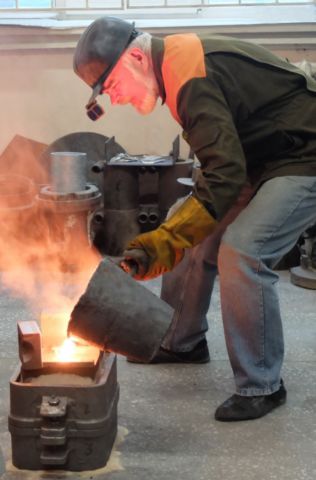Scientists from the SUSU Institute of Engineering and Technology have patented a new method for making a casting mould for the production of metal parts. The new technological method is environmentally friendly and increases labour productivity in the same time compared to traditional production methods. The technology is useful for the branches of mechanical engineering, rocket engineering, and aircraft engine building.
There are a lot of known methods of foundry production. One of them involves making a wax casting model for future metal parts. Layers of a fire-resistant suspension, consisting of dispersed fillers (powders) and a binder, are applied on such models. The traditional composition of the binder consists of substances that require organic solvents − alcohols and acetones.
SUSU scientists propose using environmentally friendly water-based materials (aluminosols and silica sols) that are safe for humans and nature as binders.
"It is advisable to use aluminosols for casting chemically active metals and alloys, for example, titanium. The advantage of using aluminosol as a binder in a suspension is that the mould becomes more chemically inert to the alloys being poured, which means that the metal being poured does not interact with the mould since its composition is more chemically stable. And suspensions with silica sol are cheaper and are intended for steel casting," explains Boris Kulakov, Doctor of Sciences (Engineering), Professor at the SUSU Department of Pyrometallurgical and Foundry Technologies.
The next stage of foundry production consists of drying the layers of refractory suspension applied to the model. Scientists use vacuum to dry the aluminosol suspension. The rate of water evaporation in vacuum is many times faster than when blowing with air − it will take about 20 minutes to dry one layer, instead of 4 hours. The silica sol suspension requires air drying, but the advantage of using such material is that there is no need to re-equip the production line.
In order to make a metal part from a wax model, you need to make a ceramic double of it and pass it through the calcination stage in an oven. After this, the ceramic mould can be used for pouring metal.
Now the technology is completely ready for transfer to industrial enterprises. The technology for making a wax model using a refractory suspension, which includes silica sols, is already being used by the INKO research and production company in the city of Kopeysk. Master's degree students of the SUSU Department of Pyrometallurgical and Foundry Technologies Nikita Nizovtsev and Fedor Savin took part in the development.





.JPG)